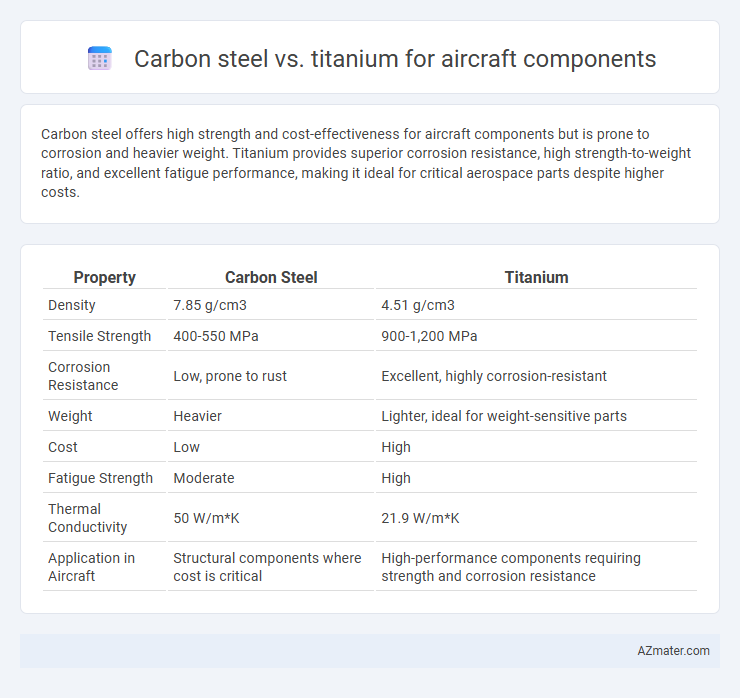Carbon steel offers high strength and cost-effectiveness for aircraft components but is prone to corrosion and heavier weight. Titanium provides superior corrosion resistance, high strength-to-weight ratio, and excellent fatigue performance, making it ideal for critical aerospace parts despite higher costs.
Table of Comparison
| Property | Carbon Steel | Titanium |
|---|---|---|
| Density | 7.85 g/cm3 | 4.51 g/cm3 |
| Tensile Strength | 400-550 MPa | 900-1,200 MPa |
| Corrosion Resistance | Low, prone to rust | Excellent, highly corrosion-resistant |
| Weight | Heavier | Lighter, ideal for weight-sensitive parts |
| Cost | Low | High |
| Fatigue Strength | Moderate | High |
| Thermal Conductivity | 50 W/m*K | 21.9 W/m*K |
| Application in Aircraft | Structural components where cost is critical | High-performance components requiring strength and corrosion resistance |
Introduction: Carbon Steel vs Titanium in Aerospace
Carbon steel offers high strength and excellent machinability, making it a cost-effective choice for certain aerospace components. Titanium provides superior corrosion resistance, high strength-to-weight ratio, and exceptional fatigue performance, which are critical for advanced aircraft structures. The selection between carbon steel and titanium depends on specific performance requirements, with titanium increasingly favored for weight reduction and durability in aerospace applications.
Material Properties Comparison
Carbon steel offers high strength and excellent wear resistance, making it suitable for load-bearing aircraft components but suffers from higher weight and corrosion susceptibility. Titanium provides superior strength-to-weight ratio, exceptional corrosion resistance, and outstanding fatigue performance, ideal for critical aerospace parts where weight savings and durability are essential. The choice between carbon steel and titanium hinges on balancing mechanical properties, weight constraints, and environmental resistance for optimal aircraft component performance.
Weight and Density Differences
Carbon steel has a density of approximately 7.85 g/cm3, making it significantly heavier than titanium, which has a density around 4.51 g/cm3. This substantial difference in density means titanium components contribute to a lighter aircraft structure, improving fuel efficiency and performance. Titanium's superior strength-to-weight ratio makes it the preferred choice for critical aerospace components where weight reduction is essential.
Strength and Durability Analysis
Titanium offers superior strength-to-weight ratio compared to carbon steel, making it ideal for aircraft components requiring high tensile strength and resistance to fatigue. Carbon steel provides excellent durability and toughness but is significantly heavier, which can impact aircraft performance and fuel efficiency. The corrosion resistance of titanium also enhances its longevity in harsh aerospace environments, whereas carbon steel often requires protective coatings to prevent degradation.
Corrosion Resistance and Longevity
Titanium offers superior corrosion resistance compared to carbon steel, making it ideal for aircraft components exposed to harsh environmental conditions and moisture. Its ability to form a stable oxide layer prevents rust and extends the lifespan of critical parts. Carbon steel, while strong and cost-effective, is more prone to corrosion and requires protective coatings to achieve comparable longevity in aerospace applications.
Manufacturing Processes and Cost Factors
Carbon steel is favored in aircraft components for its cost-effective manufacturing processes such as forging and machining, offering high strength but with added weight and corrosion concerns. Titanium, though more expensive due to complex processes like powder metallurgy and precision machining, provides superior strength-to-weight ratio and corrosion resistance, reducing maintenance costs over the aircraft's lifespan. The trade-off between carbon steel's lower initial cost and titanium's long-term performance efficiency primarily drives material selection in aerospace manufacturing.
Performance in High-Temperature Environments
Titanium outperforms carbon steel in high-temperature environments due to its superior strength-to-weight ratio and exceptional corrosion resistance, maintaining structural integrity at temperatures up to 600degC, compared to carbon steel's lower threshold around 400degC. Titanium alloys exhibit better oxidation resistance and retain mechanical properties in extreme heat, making them ideal for critical aircraft components such as engine parts and airframes exposed to elevated temperatures. Carbon steel, while cost-effective and easier to machine, tends to lose hardness and strength, leading to potential failure under prolonged thermal stress.
Maintenance and Repair Considerations
Titanium offers superior corrosion resistance and strength-to-weight ratio compared to carbon steel, significantly reducing maintenance frequency and costs in aircraft components. Carbon steel, while easier to machine and repair due to its ductility, is more susceptible to corrosion and requires regular inspections and surface treatments to prevent degradation. Repair techniques for titanium are often more specialized and costly, necessitating advanced welding methods and skilled technicians to maintain structural integrity.
Application Suitability for Various Aircraft Components
Carbon steel offers high strength and excellent wear resistance, making it suitable for structural components such as landing gear and fasteners that require durability under heavy loads. Titanium provides superior corrosion resistance and a high strength-to-weight ratio, ideal for critical parts like engine components and airframes where weight reduction and performance are paramount. The selection between carbon steel and titanium depends on the specific aircraft component's requirements for strength, weight savings, and environmental resistance.
Conclusion: Optimal Choice for Aircraft Components
Titanium is the optimal choice for aircraft components due to its superior strength-to-weight ratio, corrosion resistance, and fatigue durability compared to carbon steel. Its lightweight properties contribute to improved fuel efficiency and overall aircraft performance. While carbon steel offers cost advantages, titanium's performance benefits make it the preferred material in critical aerospace applications.

Infographic: Carbon steel vs Titanium for Aircraft component
 azmater.com
azmater.com